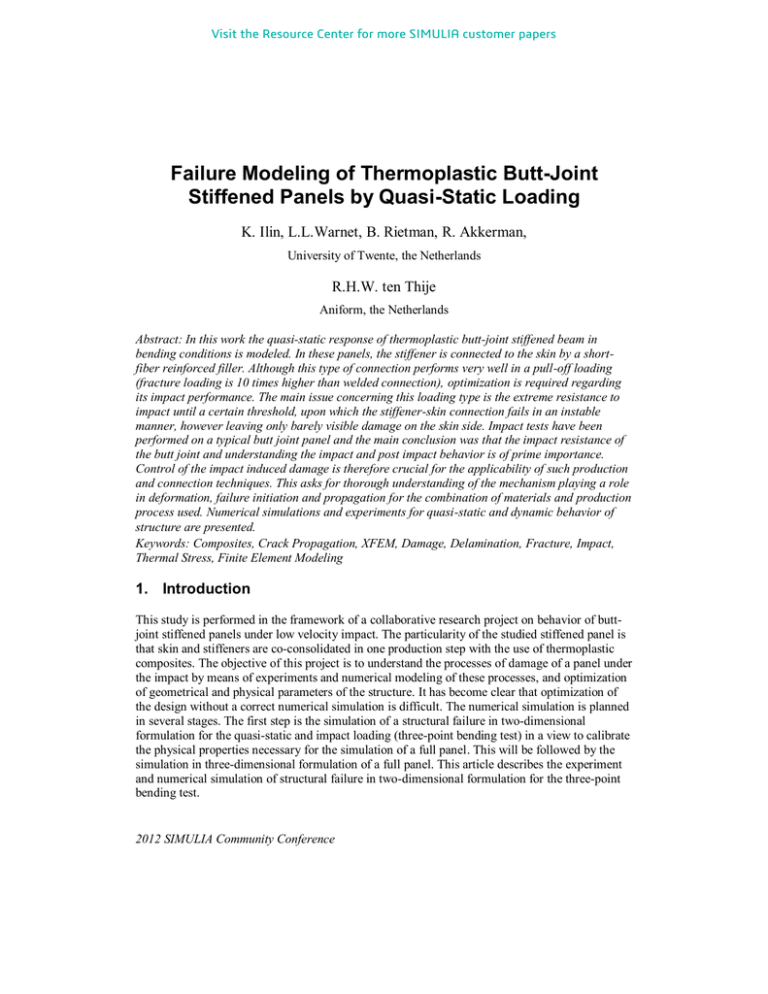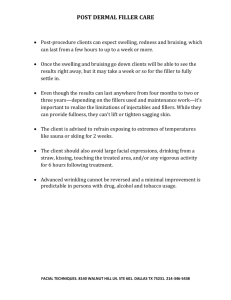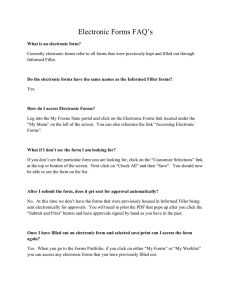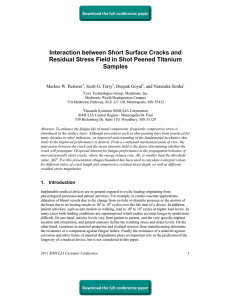Failure Modeling of Thermoplastic Butt-Joint Stiffened Panels by Quasi-Static Loading
advertisement

Visit the Resource Center for more SIMULIA customer papers Failure Modeling of Thermoplastic Butt-Joint Stiffened Panels by Quasi-Static Loading K. Ilin, L.L.Warnet, B. Rietman, R. Akkerman, University of Twente, the Netherlands R.H.W. ten Thije Aniform, the Netherlands Abstract: In this work the quasi-static response of thermoplastic butt-joint stiffened beam in bending conditions is modeled. In these panels, the stiffener is connected to the skin by a shortfiber reinforced filler. Although this type of connection performs very well in a pull-off loading (fracture loading is 10 times higher than welded connection), optimization is required regarding its impact performance. The main issue concerning this loading type is the extreme resistance to impact until a certain threshold, upon which the stiffener-skin connection fails in an instable manner, however leaving only barely visible damage on the skin side. Impact tests have been performed on a typical butt joint panel and the main conclusion was that the impact resistance of the butt joint and understanding the impact and post impact behavior is of prime importance. Control of the impact induced damage is therefore crucial for the applicability of such production and connection techniques. This asks for thorough understanding of the mechanism playing a role in deformation, failure initiation and propagation for the combination of materials and production process used. Numerical simulations and experiments for quasi-static and dynamic behavior of structure are presented. Keywords: Composites, Crack Propagation, XFEM, Damage, Delamination, Fracture, Impact, Thermal Stress, Finite Element Modeling 1. Introduction This study is performed in the framework of a collaborative research project on behavior of buttjoint stiffened panels under low velocity impact. The particularity of the studied stiffened panel is that skin and stiffeners are co-consolidated in one production step with the use of thermoplastic composites. The objective of this project is to understand the processes of damage of a panel under the impact by means of experiments and numerical modeling of these processes, and optimization of geometrical and physical parameters of the structure. It has become clear that optimization of the design without a correct numerical simulation is difficult. The numerical simulation is planned in several stages. The first step is the simulation of a structural failure in two-dimensional formulation for the quasi-static and impact loading (three-point bending test) in a view to calibrate the physical properties necessary for the simulation of a full panel. This will be followed by the simulation in three-dimensional formulation of a full panel. This article describes the experiment and numerical simulation of structural failure in two-dimensional formulation for the three-point bending test. 2012 SIMULIA Community Conference It will be shown that for the conditions chosen, the damage development in these joints include fracture of the filler, delamination between filler and laminate, and in the laminate in combination with transverse cracks. Figure 1 shows the process of crack initiation and growth as observed during the experiment using a high speed camera, as the process is brittle. Figure 1. The three-point bending test sketch (top) and initiation and propagation of the crack (bottom). The paper will first show the experimental results (1) with the typical fracture modes, and will be followed by description of the model used (2) and results of simulation (3). 2 2012 SIMULIA Community Conference 2. Experimental damage characterization The sequence of steps for the experiment is as follows: - Process – co-consolidation of skin and stiffener with an injection molded filler - Narrow specimens are cut to prepare the testing specimens - Are tested in a simply supported three-point bending set-up in a universal testing equipment In the three-point bending test a T-joint sample is loaded in a three point bending set-up. The ends of the T are simply supported. The material of the skin and rib are PEKK AS4 and the material of the filler is PEKK FC 20%. The skin consists of 16 layers oriented in pattern. The test sample has a length of The radius of the support is . , width of and the radius of the filler of . The radius of the loading cylinder is . . The load rate is Figure 2. Example of damage process in three-point bending test. Figure 2 shows the damage development in more details. First, the crack is initiated and propagated in the filler (a-b), then the delamination happens between the filler and the laminate (c), after that the transverse crack appears in the laminate (d), finally a delamination happens within the skin (e). Note that the stages (d) and (e) are not necessary present. This depends on the geometry, layers orientation, acting force etc. For example, these stages are not present in the experiment which we use for modeling. The crack development described is also responsible for a force drop of about 20%. 2012 SIMULIA Community Conference 3. Modeling A difficulty of modeling of such structures arises from the fact that the properties of the laminated part skin and short-fiber part filler are not know exactly. As a hypothesis we assumed isotropic properties of the filler, but strictly speaking it is not entirely true. In the process of moulding this part, the fibers in it are arranged in some order, not randomly. The assumption of isotropy of the filer material allows applying the XFEM method [2] to model the crack initiation and propagation in the filler. Once the crack reaches the skin, the delamination occurs between the skin and the filler. This process was simulated using a contact based cohesive model [2]. In the experiment, the damage was not observed within the skin, therefore the model for the damage of the skin has not been developed. The approach of using two different methods of the damage modeling within one model (used for example in [1]) has proven to provide reliable results. The model was created in Abaqus/CAE. As shown in [3] to obtain accurate results, the use of plane-stress or plane-strain formulation of the problem in this case is impossible. This is due to the fact that the simulation of the laminated composites with different ply angles in 2D does not account for the three-dimensional effects. At the same time modeling in 3D requires too much time and resources. Therefore, in this case a compromise modeling was chosen with one layer of the three-dimensional elements C3D20R in width, but with boundary conditions that limit displacement of the boundary nodes (Figure 3). The supports and the loading cylinder are modeled as rigid analytical surfaces. Figure 3. Schematics of the model with the boundary conditions. The rib was modeling as a rigid body too, as the real stiffness of the rib has no influence on the construction stiffness. Figure 3 shows the boundary conditions as used in the model. 4 2012 SIMULIA Community Conference The material properties of the layers are orthotropic, while for the filler is taken as isotropic. Note that the material properties of the filler as well as its damage parameters are not yet know precisely due to its inherent micro anisotropy. Elastic properties of the individual layers are: , , the filler material are , . , , The average size of the elements is about . , . The elastic properties of To account for the thermal residual stress we used the thermal expansion coefficients , for the skin and for the filler. The temperature drop is . The critical stress for crack origination is assumed as and critical energy release rate for crack propagation of with BK law. It is worth to mention again that the exact values of the fracture energy is not yet known. Figure 4. Methods used in damage modeling. It looks like a relatively simple XFEM method (as compared to the cohesive methods) based on the linear-elastic fracture mechanics is sufficiently accurate to be used for the filler because its material is rather brittle (Figure 4). For modeling of delamination between the filler and the skin, a more complex contact based cohesive model was used. In this model the damage is described by the dependence of the contact stresses on the distance between the contact surfaces. The parameters of the model are: the normal stiffness component , the peak value of the contact separation , and the separation at failure . At present we do not have the exact data of this energy between the skin and the filler. A dedicated experiment is needed. Therefore we selected the parameters for the model empirically as a first approximation. 2012 SIMULIA Community Conference 4. Results As the main result of the experiment, we obtained the dependence of the reaction forces on the displacement of the upper middle point of skin. A similar dependence was obtained as a result of the simulation. A comparison between the two curves is shown in Figure 5. Figure 5. Force-displacement diagram of a T-joint in a quasi-static simply supported 3 point bending test and by simulation. 3 characteristic parameters were chosen for comparison with the earlier described experiment: - Stiffness of the stiffened beam (points 1-2) - Force/displacement at fracture (points 2) - Force drop and residual stiffness of the beam (points 2-3 and 4) A good agreement between the experimental and simulated curves can be seen. This results show that: 6 - The initial stiffness is well described by the chosen parameters - The rest stiffness is also well described and confirms the correct assumption concerning as far as the both crack and thermal stress, force at crack initiation evaluation is corrected. 2012 SIMULIA Community Conference Some parameter analysis shows that the most critical parameter is the yield stress of the filler. If yield stress changes by 10%, force and displacement at fracture (point 2 on Figure 5) changes by 9%) Figure 6 illustrates example of the deformation state of the model after the crack has been initiated in the filler and propagated along the skin. Figure 6. Deformation state of the model. 5. Conclusion The developed method allows to simulate accurately the process of damage of the T-joint composite in the three point bending test. In future we plan to develop a model describing the damage of the laminated part (skin) and to better match the experiment by verifying the damage parameters of the sample. We also plan to model in 2D and 3D the low velocity impact experiments. After we verify the method, we will perform parametric studies to reveal the influence of geometry, layers orientation etc. on the results. 6. References 1. Lembke, M, “Modeling the mechanical response of multiphase recycled CFRP,” Imperial College, Department of Aeronautics, London, England, 2010. 2. Abaqus Users Manual, Version 6.10-1, Dassault Systémes Simulia Corp., Providence, RI. 3. Ronald Krueger and Pierre J.Minguet, “Influence of 2D finite element modeling assumptions on debonding prediction for composite skin-stiffener specimens subjected to tension and bending,” NASA/CR-2002-211452, ICASE Report No.2002-4 2012 SIMULIA Community Conference Visit the Resource Center for more SIMULIA customer papers






